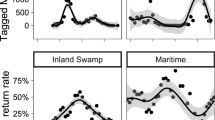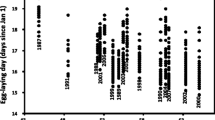Abstract
Captive breeding has been suggested as a method of conserving many threatened vertebrates, and is increasingly being proposed as a valuable conservation strategy for invertebrates. Potential genetic problems associated with ex situ conservation are widely recognized, but a further issue has received less attention: the possibility that populations will undergo adaptation to the captive environment, rendering them less well adapted to survival in the wild. We investigated six traits related to dispersal and reproduction in a culture of the large white butterfly Pieris brassicae (L.), that had been captive for c. 100–150 generations, and in recently wild stock reared simultaneously in a common environment. Individuals in the captive culture were heavier, with smaller wings and lower wing aspect ratios. Females from the captive culture laid many more eggs in cage experiments, and had higher ovary mass at the time of peak egg production. These differences are consistent with adaptation to captive conditions. Over time, similar evolutionary changes may affect invertebrates reared in ex situ conservation programmes, decreasing the likelihood that these species can be re-established in the wild. Although the timescale over which most vertebrates are likely to adapt to captivity is longer, and the traits involved will be different, invertebrates like P. brassicae may also provide a model of potential problems in long-term ex situ conservation programmes for both invertebrates and vertebrates. We suggest that measures to reduce or slow adaptation to captivity should be introduced alongside measures to reduce deleterious genetic effects in captive populations.
Similar content being viewed by others
References
Ayala, F.J. (1965) Evolution of fitness of experimental populations of Drosophila serrata. Science 150, 903-5.
Balmford, A., Mace, G.M. and Leader-Williams, N. (1996) Designing the ark: setting priorities for captive breeding. Conserv. Biol. 10, 719-27.
Betts, C.R. and Wootton, R.J. (1988) Wing shape and flight behaviour in butterflies (Lepidoptera: Papilionoidea and Hesperioidea): a preliminary analysis. J. Exp. Biol. 138, 271-88.
Boggs, C.L. (1986) Reproductive strategies of female butterflies: variation in and constraints on fecundity. Ecol. Entomol. 11, 7-15.
Bryant, E.H. and Reed, D.H. (1999) Fitness decline under relaxed selection in captive populations. Conserv. Biol. 13, 665-9.
Bush, G.L., Neck, R.W. and Kitto G.B. (1976) Screworm eradication: inadvertent selection for non-competitive ecotypes during mass rearing. Science 193, 491-3.
Caro, T. (1999) The behaviour-conservation interface. Trends Ecol. Evol. 14, 366-9.
David, W.A.L. and Gardiner, B.O.C. (1962) Oviposition and the hatching of the eggs of Pieris brassicae (L.) in a laboratory culture. Bull. Entomol. Res. 53, 91-109.
Ebenhard, T. (1995) Conservation breeding as a tool for saving animal species from extinction. Trends Ecol. Evol. 10, 438-43.
Feltwell, J. (1982) Large white butterfly. The biology, biochemistry and physiology of Pieris brassicae (L.). The Hague: W. Junk.
Fleming, I.A., Jonsson, B., Gross, M.R. and Lamberg, A. (1996) An experimental study of the reproductive behaviour and success of farmed and wild Atlantic salmon (Salmo salar). J. Appl. Ecol. 33, 893-905.
Frankel, O.H. and Soulé, M.E. (1981) Conservation and evolution. Cambridge University Press, Cambridge.
Frankham, R. and Loebel, D.A. (1992) Modeling problems in conservation genetics using captive Drosophila populations: rapid genetic adaptation to captivity. Zoo Biol. 11, 333-42.
Frankham, R. (1995) Conservation genetics. Ann. Rev. Gene. 29, 305-27.
Gunn, A. and Gatehouse, A.G. (1993) The migration syndrome in the African armyworm moth, Spodoptera exempta-allocation of resources to flight and reproduction. Physiol. Entomol. 18, 149-59.
Gunn, A., Gatehouse, A.G. and Woodrow, K.P. (1989) Trade-off between flight and reproduction in the African armyworm moth, Spodoptera exempta. Physiol. Entomol. 14, 419-27.
Hughes, D.G. and Bennett, P.M. (1991) Captive breeding and the conservation of invertebrates. Int. Zoo Yb. 30, 45-51.
IUCN (1987) The IUCNPolicy statement on captive breeding. IUCN, Gland, Switzerland.
Karlsson, B. and Wickman, P.-O. (1990) Increase in reproductive effort as explained by body size and resource allocation in the speckled wood butterfly, Pararge aegeria (L.). Func. Ecol. 4, 609-17.
Kohane, M.J. and Parsons, P.A. (1988) Domestication: evolutionary change under stress. Evol. Biol. 23, 31-48.
Lachance, S. and Magnan, P. (1990) Comparative ecology and behaviour of domestic, hybrid, and wild strains of brook trout, Salvelinus fontinalis, after stocking. Can. J. Fish. Aquat. Sci. 47, 2285-92.
Lacy, R.C. (1994) Managing genetic diversity in captive populations of animals. In Restoration of endangered species: conceptual issues, planning and implementation (M.L. Bowles and C.J. Whelan, eds), pp. 63-89. Cambridge: Cambridge University Press.
Lande, R. and Barrowclough, G.F. (1987) Effective population size, genetic variation, and their use in population management. In Viable populations for conservation (M.E. Soulé, ed), pp. 87-123. Cambridge: Cambridge University Press.
Marden, J.H. (1987) Maximum lift production during takeoff in flying animals. J. Exp. Biol. 130, 235-58.
Marden, J.H. and Chai, P. (1991) Aerial predation and butterfly design: how palatability, mimicry, and the need for evasive flight constrain mass allocation. Am. Natur. 138, 15-36.
Miyatake, T. and Yamagishi, M. (1999) Rapid evolution of larval development time during mass-rearing in the melon fly, Bactrocera cucurbitae. Res. Popul. Ecol. 41, 291-7.
Morton, A.C. (1991) Captive breeding of butterflies and moths: II. Conserving variation and managing biodiversity. Int. Zoo Yb. 30, 89-97.
Nicholls, C.N. and Pullin, A.S. (2000) A comparison of larval survivorship in wild and introduced populations of the large copper butterfly (Lycaena dispar batavus). Biol. Conserv. 93, 349-358.
Pearce-Kelly, P., Jones, R., Clarke, D., Walter, C., Atkin, P. and Cunningham, A.A. (1998) The captive rearing of threatened orthoptera: a comparison of the conservation potential and practical considerations of two species' breeding programmes at the Zoological Society of London. J. Insect Conserv. 2, 201-10.
Philippart, J.C. (1995) Is captive breeding an effective solution for the preservation of endemic species? Biol. Conserv. 72, 281-95.
Pollard, E. and Yates, T. (1995) Monitoring butterflies for ecology and conservation. London: Chapman & Hall.
Price, E.O. (1984) Behavioural aspects of animal domestication. Quart. Rev. Biol. 59, 1-32.
Rahbek, C. (1993) Captive breeding-a useful tool in the preservation of biodiversity? Biodiver. Conserv. 2, 426-37.
Rankin, M.A. and Burchsted, J.C.A. (1992) The cost of migration in insects. Ann. Rev. Entomol 37, 533-59.
Roff, D.A. (1984) The cost of being able to fly: a study of wing polymorphism in two species of crickets. Oecologia (Berlin) 63, 30-7.
Roff, D.A. (1990) The evolution of flightlessness in insects. Ecol. Monogr. 60, 389-421.
Roff, D.A. (1991) Life history consequences of bioenergetic and biomechanical constraints on migration. Am. Zool. 31, 205-15.
Ryman, N. (1991) Conservation genetics considerations in fishery management. J. Fish Biol. 39 (Suppl. A), 211-24.
Saccheri, I.J., Brakefield, P.M. and Nichols, R.A. (1996) Severe inbreeding depression and rapid fitness rebound in the butterfly Bicyclus anynana (Satyridae). Evolution 50, 2000-13.
Sgro C.M. and Partridge, L. (2000) Evolutionary responses of the life history of wild-caught Drosophila melanogaster to two standard methods of laboratory culture Am. Natur. 156, 341-53.
Soulé, M.E. and Wilcox, B.A. (eds) (1980) Conservation Biology: an evolutionary ecological perspective. Sinauer, Sunderland, Massachusetts.
Soulé, M., Gilpin, M., Conway, W. and Foose, T. (1986) The millennium ark: how long a voyage, how many staterooms, how many passengers? Zoo Biol. 5, 101-13.
Spieth, H.R. and Kaschuba-Holtgrave, A. (1996) A new experimental approach to investigate migration in Pieris brassicae L. Ecol. Entomol. 21, 289-94.
Srygley, R.B. and Chai, P. (1990) Flight morphology of neotropical butterflies: palatability and distribution of mass to the thorax and abdomen. Oecologia (Berlin) 84, 491-9.
Stockwell, C.A. and Weeks, S.C. (1999) Translocations and rapid evolutionary change in recently established populations of western mosquitofish (Gambusia affinis). Ani. Conserv. 2, 103-10.
Sutherland, W.J. (1998) Managing habitats and species. In Conservation science and action, (W.J. Sutherland, ed), pp. 202-19. Oxford: Blackwell Science.
Van Swaay, C.A.M. and Warren, M.S. (1999) Red Data Book of European butterflies (Rhopalocera). Nature and environment, No. 99, Council of Europe Publishing, Strasbourg.
Wicklund, C., Nylin, S. and Forsberg, J. (1991) Sex-related variation in growth rate as a result of selection for large size and protandry in a bivoltine butterfly (Pieris napi L.). Oikos 60, 241-50.
Wickman, P.-O. and Karlsson, B. (1989) Abdomen size, body size, and the reproductive effort of insects. Oikos 56, 209-14.
Zar, J.H. (1984) Biostatistical analysis. London: Prentice-Hall.
Zera, A.J. and Denno, R.F. (1997) Physiology and ecology of dispersal polymorphism in insects. Ann. Rev. Entomol. 42, 207-31.
Zouros, E., Loukas, M., Economopolos, A. and Mazomenos, B. (1982) Selection at the alcohol dehydrogenase locus of the olive fruit fly Dacus oleae under artificial rearing. Heredity 48, 169-85.
Author information
Authors and Affiliations
Corresponding author
Rights and permissions
About this article
Cite this article
Lewis, O.T., Thomas, C.D. Adaptations to Captivity in the Butterfly Pieris brassicae (L.) and the Implications for Ex situ Conservation. Journal of Insect Conservation 5, 55–63 (2001). https://doi.org/10.1023/A:1011348716934
Issue Date:
DOI: https://doi.org/10.1023/A:1011348716934




